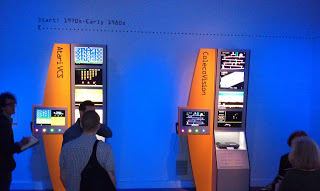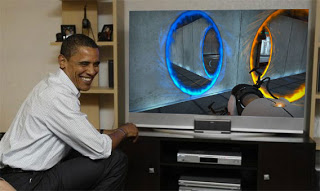This post has not been edited by the GamesBeat staff. Opinions by GamesBeat community writers do not necessarily reflect those of the staff.
By Justin Brenis and Jason Parris
A few years ago while browsing YouTube for gameplay videos of various games Justin stumbled on to a speech given by thatgamecompany's current president, Kellee Santiago at a TEDx event at USC.
The focus of her speech was built around comments made–and now beaten to death in our industry–by Roger Ebert, who said that video games would never be accepted as art. He later revised this statement, in response to Santiago's speech, saying that while they may be art some day, no person living today will live to see the day they are.
It was Santiago's speech that really got both of us thinking about this issue. Her argument that games are already art, and have been for quite some time, hits a chord. After all, from BioShock on all the way back to Mega Man 4 on the NES, elements of these games–be it the music, the graphics or the narratives–stand strong in the minds of all who played them as representations of the kind of art you see in legitimate museums.
Fast-forward to today, and Pixel Perfect can excitedly report on attending The Art of Video Games exhibit, the first games-as-art exhibit of its kind, at none other than the Smithsonian American Art Museum in Washington, D.C.
Having the unique opportunity to attend as a member of the press, we were able to walk the exhibit a day before it opened to the public. This allowed us to spend considerable time with each aspect of the exhibit and really gain an appreciation for the message being conveyed.
Guest curator of the exhibit, Chris Melissinos, who those old enough will remember as a member of the early team at Sun Microsystems, offered remarks to the press the day before the exhibition opened to the public. He offered his thoughts on where games are, and where they are headed. And his remarks were, well, rather remarkable, to say the least.
Focusing on where video games were at their birth forty years ago and the journey to where they are today, he truly believes that we have hit a point of cultural acceptance, and that games are a craft that allows for never-before-seen creativity and expression.
"Think about it," he offered, "This is coming generation will be the first generation of gamers raised by gamers." He went on, reminding the audience, "Remember, within the next two election cycles, we will have a President in the White House who grew up playing video games."
|
Hey, it could happen! |
Melissinos, who provided the majority of the exhibit's featured consoles from his own working home collection, spent the rest of his time discussing just how video games, in his opinion, became the art form deserving of attention from an institution as prestigious as the Smithsonian. His is a concept of three voices: the artist (or developer), the game itself, and the player (or gamer).
At the first level, the artist has the vision for the end piece they wish to create; the story they want told. Using the tools available to them and pressing the boundaries of technology, the artist creates a world that inhabits the end product. This includes all of the music, artwork, dialogue and other more traditional art forms that go into a video game.
The second voice is the game itself. In Melissinos' view, the game speaks through its mechanics. Is there an upgrade system? Is it a first-person or third-person perspective? Games are interactive, after all, so the mechanics you use to interact with the game are a part of what makes video games a unique art form.
But it is the third level, the player, that makes games so dynamic, according to Melissinos. He sees games as one of the first–or at the very least most well-known–interactive art forms in existence. The artist can create something, but has no control over how it will be used. So, the player adds his or her own voice to the final art that is a video game.
In his eyes, the nexus of the three is where art happens. A game is not art until it is being played.
 This core concept was exceedingly clear upon entering the exhibit. Enthusiast gamers, those who have been playing since they were old enough to hold a controller, will squirm with glee at the front door, where an entire wall has turned into a constant montage of clips from the best games from the medium's forty year history.
This core concept was exceedingly clear upon entering the exhibit. Enthusiast gamers, those who have been playing since they were old enough to hold a controller, will squirm with glee at the front door, where an entire wall has turned into a constant montage of clips from the best games from the medium's forty year history.
The first room is dedicated to the first voice, the artists and their process. The walls surrounding you are adorned with concept art from iconic titles like Sonic the Hedgehog, World of Warcraft, StarCraft, Fallout 3 and more. Video screens offer documentary-style interviews on the development process from heavy-hitters like Tim Schafer, Kellee Santiago and Warren Spector.
An especially interesting display has three flat screens intermittently showing footage of people of all ages and races playing games. You don't see or hear what they're playing. You just watch the emotions that the game draws out of them–raw footage of interactive art hitting home.
The second room is dedicated to the second and third voices in video games, the mechanics and the player. Here, you'll have a chance to experience some of the finest examples of the medium. Five huge screens are set up with Pac-Man, Super Mario Bros., The Secret of Monkey Island, Myst and Flower. Each offers roughly five minutes of gameplay per turn.
While a cynic might say that this is simply as an excuse to let people say they've played games in a museum, playing all of the games–in that order, particularly–provides a tactile experience that only enhances the exhibit's final room.
There, guests are treated to a history video game platforms. It may be easily confused with an Antiques Road show for technology, this room really drove home the evolution of the artists' toolkit–their paint and easel.
Starting with the Atari and ColecoVision in the 1970's and wrapping all the way around to the 360, Wii and PS3, this room features four games per platform, one from each of the genres that were open for public voting when the exhibit was announced. The displays have a short video segment for each game with some discussion of the game.
The room is laid out by the same technological eras as the first room:
- Start!, the earliest home gaming from the 1970's to the early 80's. Basically, everything before the NES.
- 8-bit, which includes the NES, Sega Master System and the Commodore 64 (a.k.a. awesome childhood memories).
- Bit Wars!, or the era when the SNES and Genesis went head-to-head.
- Transition, which covers the transition into true 3D gaming. This is also where PC gaming gets its first shout-out, and who doesn't love a good DOS game?
- Next Generation, somewhat ironically, is all about the just past and current console generation.
We especially appreciated how an equal amount of time and space was dedicated to each of the eras.
What this room is really about, however, is what the developers' first step towards their completed work. Pac-Man, for example, was an arcade game that Atari brought to the Atari VCS (as Melissinos prefers to refer to what is more commonly known as the "Atari 2600"). Older gamers might remember that the ghosts in the home version flickered constantly as they moved. Turns out, that's because the hardware could only render one ghost on screen at once.
Some might call it a glitch or a design choice gone wrong. In his speech Friday night, Nolan Bushnell hinted that it might have been foolish to even try to adapt the arcade game. But, in actuality, this is where innovation comes from, and that's how the abstract pixels of the past have become the almost photo-realistic texture maps of today.
Furthermore, it is this pushing and pulling on the available technology, taking your raw materials and making something greater than the sum of its parts, something that has never been done before, that so closely mirrors our traditional view of an artist in front of a canvas splattered with fresh paint in all directions. At least, that is what Melissinos really seemed to want the audience to connect with in his exhibit. Of course, your interpretation may vary.
Despite being abruptly short, Melissinos' exhibition has undoubtedly achieved what it sets out to do: convey the forty-year birth of a new art form.
As mentioned before, seasoned gamers will feel right at home in the exhibit. Wandering from room to room, playing games, looking at concept art and learning a surprising amount while reminiscing about some of your favorite gaming memories, it goes without saying that you're pretty much guaranteed to have fun.
There are really two aspects of the exhibit that are far more noteworthy, however.
First, the experience of those who are less experienced with games. The middle-aged mother and father who got their hands on Pong and Pac-Man back in the day but haven't touched a controller since, or the grandparents who buy their grandchildren the newest game while wondering aloud about what happened to playing outdoors. Or even the younger generation, those who are in their teens or younger who have only ever heard of Atari or Monkey Island.
The way the exhibit touched those sorts of people was impressive, to say the least.
True, the average gamer is now 37 years old, but while we were there, it seemed like many of the older individuals who came through the exhibit were regular museum-goers rather than enthusiasts who came for the exhibit.
It was great to overhear men and women, usually 50 or older, standing in front of the Pac-Man terminal dispatching with level after level with ease explaining to those around why Super Mario Bros. still stands strong today in a world with HD gaming. Even more interesting were the conversations they would spontaneously have with younger people in the exhibit. Clearly, the exhibition has spurred more than just mild curiosity in its patrons.
Second, The Art of Video Games drew an audience into the Smithsonian Museum of American Art that would never have ventured in otherwise. And really, that's a huge accomplishment in itself.
Not everyone was impressed, however. A number of visitors felt the exhibit was far too short and, perhaps having not thought hard enough about the mission of the exhibit, wanted to see more of their favorite games just for the sake of seeing them there. Others, while generally impressed, were so well-versed in the subject that they craved a deeper experience–more information that was new to them. Those of the latter viewpoint who we talked to generally agreed that the exhibit was a good first step, however.
Unfortunately, some complaints from the older crowd were focused on, let's call it "video game media bias." As Pixel Perfect has covered before, the media tends to be unfairly negative about video games, claiming that games keep kids fat and indoors, socially withdrawn and breeding hidden proclivities for violence.
These people came in and saw an exhibit honoring something they themselves feel is, at best, more entertainment than art, belonging in a museum of technology or media rather than where it is.
Surprisingly, Hideo Kojima offered up the best argument for that viewpoint. He explained, during his discussion at GameFest, that he feels that a video game is a combination of many different arts, that a game is a medium that provides music, visual art and storytelling all combined together as a service to the player, but not as a separate art form itself. He did concede that "it is something that could be perceived as art," however.
Clearly, this is a debate that can't be fully covered in this article, and Pixel Perfect will continue to cover our culture's shifting perspectives on video games in the future.
Those looking for an even deeper level of appreciation will find it in Melissinos' book, The Art of Video Games: From Pac-Man to Mass Effect, co-written by Patrick Rourke. Copies of it are scattered throughout the exhibit, and they're also available in the museum's gift shop or online. It offers what Melissinos called, "an in-game user's manual" experience for both those familiar and unfamiliar with games.
The book offers over two hundred pages of large screenshots from games from the past forty years as well as excellent essays and interviews with some of the industry’s most notable celebrities. Nolan Bushnell, Tommy Tallarico and others offer their thoughtful opinions interspersed between the pictures and descriptions of their games. It's a great read, a great guide and an excellent coffee table book.
Overall, the experience was nothing short of incredible. Pixel Perfect encourages each of your get out to Washington, D.C., before mid-September, or at least check out when the exhibit is at a museum near you while it's on tour. The list of confirmed venues is available on the Smithsonian's website.


